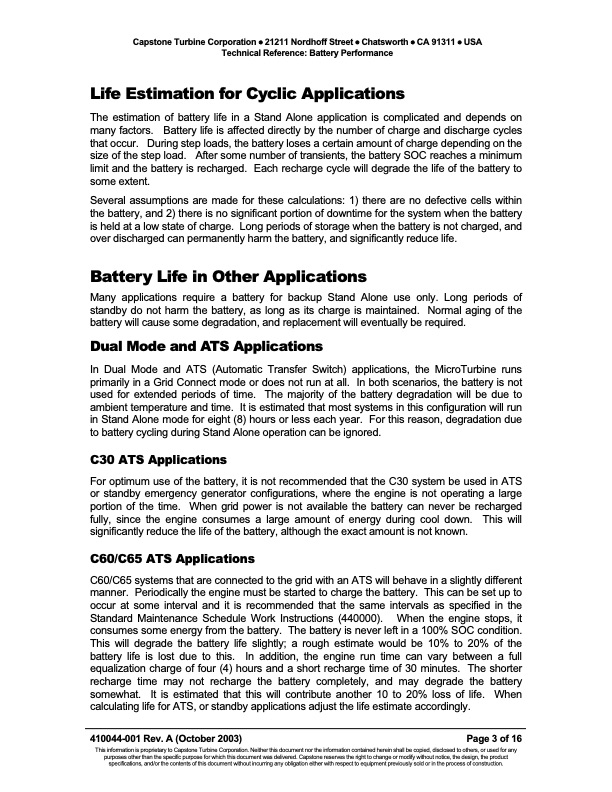
PDF Publication Title:
Text from PDF Page: 003
Capstone Turbine Corporation • 21211 Nordhoff Street • Chatsworth • CA 91311 • USA Technical Reference: Battery Performance Life Estimation for Cyclic Applications The estimation of battery life in a Stand Alone application is complicated and depends on many factors. Battery life is affected directly by the number of charge and discharge cycles that occur. During step loads, the battery loses a certain amount of charge depending on the size of the step load. After some number of transients, the battery SOC reaches a minimum limit and the battery is recharged. Each recharge cycle will degrade the life of the battery to some extent. Several assumptions are made for these calculations: 1) there are no defective cells within the battery, and 2) there is no significant portion of downtime for the system when the battery is held at a low state of charge. Long periods of storage when the battery is not charged, and over discharged can permanently harm the battery, and significantly reduce life. Battery Life in Other Applications Many applications require a battery for backup Stand Alone use only. Long periods of standby do not harm the battery, as long as its charge is maintained. Normal aging of the battery will cause some degradation, and replacement will eventually be required. Dual Mode and ATS Applications In Dual Mode and ATS (Automatic Transfer Switch) applications, the MicroTurbine runs primarily in a Grid Connect mode or does not run at all. In both scenarios, the battery is not used for extended periods of time. The majority of the battery degradation will be due to ambient temperature and time. It is estimated that most systems in this configuration will run in Stand Alone mode for eight (8) hours or less each year. For this reason, degradation due to battery cycling during Stand Alone operation can be ignored. C30 ATS Applications For optimum use of the battery, it is not recommended that the C30 system be used in ATS or standby emergency generator configurations, where the engine is not operating a large portion of the time. When grid power is not available the battery can never be recharged fully, since the engine consumes a large amount of energy during cool down. This will significantly reduce the life of the battery, although the exact amount is not known. C60/C65 ATS Applications C60/C65 systems that are connected to the grid with an ATS will behave in a slightly different manner. Periodically the engine must be started to charge the battery. This can be set up to occur at some interval and it is recommended that the same intervals as specified in the Standard Maintenance Schedule Work Instructions (440000). When the engine stops, it consumes some energy from the battery. The battery is never left in a 100% SOC condition. This will degrade the battery life slightly; a rough estimate would be 10% to 20% of the battery life is lost due to this. In addition, the engine run time can vary between a full equalization charge of four (4) hours and a short recharge time of 30 minutes. The shorter recharge time may not recharge the battery completely, and may degrade the battery somewhat. It is estimated that this will contribute another 10 to 20% loss of life. When calculating life for ATS, or standby applications adjust the life estimate accordingly. 410044-001 Rev. A (October 2003) Page 3 of 16 This information is proprietary to Capstone Turbine Corporation. Neither this document nor the information contained herein shall be copied, disclosed to others, or used for any purposes other than the specific purpose for which this document was delivered. Capstone reserves the right to change or modify without notice, the design, the product specifications, and/or the contents of this document without incurring any obligation either with respect to equipment previously sold or in the process of construction.PDF Image | Technical Reference Battery Performance

PDF Search Title:
Technical Reference Battery PerformanceOriginal File Name Searched:
410044_Battery_Performance.pdfDIY PDF Search: Google It | Yahoo | Bing
Capstone Turbine and Microturbine: Capstone microturbines used and new surplus for sale listing More Info
Consulting and Strategy Services: Need help with Capstone Turbine, sizing systems, applications, or renewable energy strategy, we are here to assist More Info
Container Lumber Dry Kiln: Since 1991 developing and innovating dry kilns using standard shipping containers More Info
Supercritical CO2 Lumber Dry Kiln: Compact fast drying in 3 days or less for small amounts of wood and lumber drying More Info
BitCoin Mining: Bitcoin Mining and Cryptocurrency... More Info
Publications: Capstone Turbine publications for microturbine and distributed energy More Info
FileMaker Software for Renewable Energy Developing database software for the renewable energy industry More Info
CO2 Gas to Liquids On-Demand Production Cart Developing a supercritical CO2 to alcohol on-demand production system (via Nafion reverse fuel cell) More Info
Stranded Gas for low cost power Bitcoin Mining Using stranded gas for generators may provide breakthrough low power costs for cryptocurrency miners. More Info
| CONTACT TEL: 608-238-6001 Email: greg@globalmicroturbine.com | RSS | AMP |